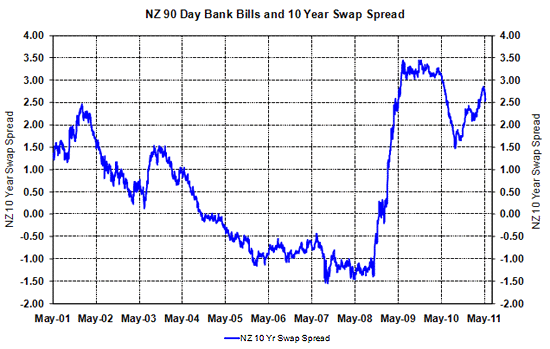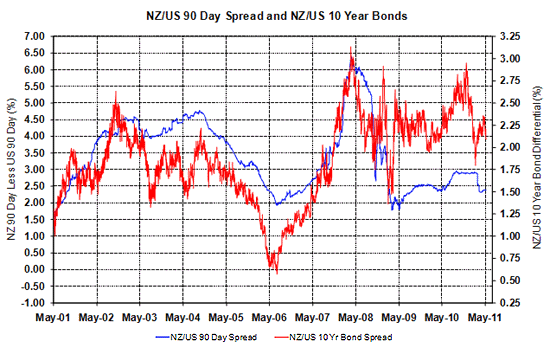

By Roger J Kerr
Will the New Zealand interest rate yield curve be as steeply upward sloping in 12 months time as it is now?
Currently there is a 2.5% gap between 90-day rates at 2.70% and 10-year swap yields at 5.20% (see chart below).
While there is a fair amount of confidence that the 90-day rates will be moving higher rather rapidly in early 2012 as the RBNZ realise they are behind the 8-ball in respect to monetary settings against a higher inflation/GDP growth track, the yield curve slope at that time will depend whether long-term interest rates move concurrently higher.
While I can see 90-day interest rates increasing by 2.00% in 2012 to 4.70%, the expected increase in 10-year swap rates will probably be limited to between 1.00% and 1.50%.
Therefore, in 12 months time the 90-day/10-year gap should reduce to around 1.50%. "Neutral" monetary policy settings by the RBNZ at that time will therefore still have an upward sloping yield curve.
I think it will be a very long time before we see any return to an inverse yield curve with short-term rates above long-term interest rates.
The RBNZ are going to be less reliant on jacking up short-term rates to slow the economy to control inflation in the future. The core funding ratio regulation over the banks provides them with another lever to pull and generally higher bank lending margins means that market short-term interest rates do not have to be as high as historical levels to slow the economy.
More than 50% of home mortgage borrowers now on variable rate also means that the RBNZ have more immediate leverage over consumer spending behaviour - not that the current and future inflation increases are coming from the consumer demand side of the equation anyway.
I do not see the long-term swap rates being too influenced by the NZ domestic economic factors that drive the short-term rates. The factors that will determine the extent of the increase of long-term swap rates over the next 12 months include:-
- Whether new issuance (supply) of US Treasury Bonds outweighs the buying demand after the Federal Reserve stop buying massive volumes following the end of QE2 in June. The US 10-year bond yields have moved down to 3.15% since the FOMC meeting last month and the recent "safe-haven" buying as commodities reverse direction in global markets. It is really hard to see these yields going a great deal lower; however the potential to increase to 4.00% again is very real with stronger US economic growth and associated inflation risks going forward.
- The spread between US and NZ bonds is more likely to increase over the next period (certainly not decline) as NZ short-term rates increase earlier than US short-term interest rates (see chart below). A credit rating downgrade for the NZ Government would also increase the risk premium of where NZ bonds trade above their US counterpart.
- With NZ short-term rates forecast to increase substantially it is hard to see who the fixed rate receivers will be in the swaps market to drive long-term swap rates downwards. It will not be local fixed interest fund managers as they are more likely to be shortening portfolio durations than lengthening them. Borrowers are more likely to be fixed rate payers and the investment bank curve trading fraternity are not the force they use to be.
- Offshore investor demand for NZ Government bonds is likely to reduce somewhat from current very strong levels. A credit rating downgrade will potentially be one factor and a high NZD value against the USD above 0.7500 will dissuade some investors (their entry point being too high).
In a years time we will still have a normal upward sloping yield curve, however not as steep as it is now.



We welcome your comments below. If you are not already registered, please register to comment
Remember we welcome robust, respectful and insightful debate. We don't welcome abusive or defamatory comments and will de-register those repeatedly making such comments. Our current comment policy is here.